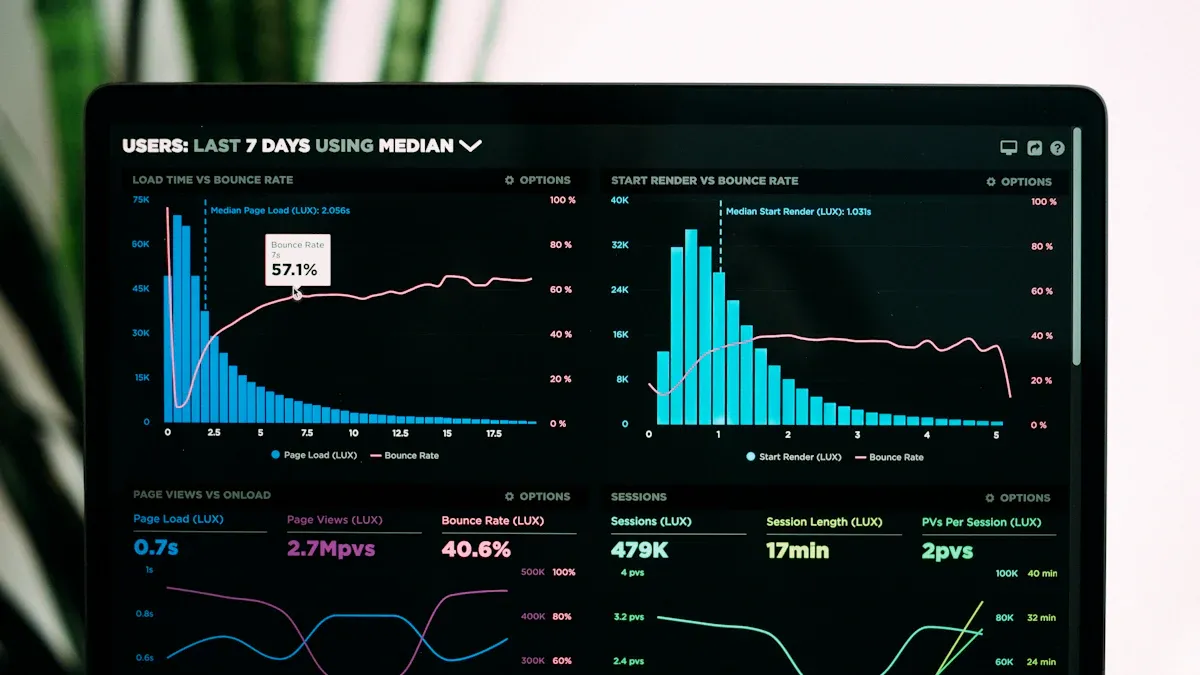Data-Driven Testing for Blog Titles with AI

You can use data-driven testing, a concept from software testing, to make your blog titles better. AI helps you separate your test logic from your test data, which leads to smarter decisions. When you let automated testing handle your titles, you save time and boost results. For example, a Danish news outlet found that AI-generated headlines increased click-through rates by 59%. You gain more engagement, work more efficiently, and scale your content faster with these modern tools.
Key Takeaways
Data-driven testing helps you find the best blog titles by using real data instead of guessing.
AI speeds up title creation and analysis, letting you test many ideas quickly and improve results.
Tracking key metrics like click-through rates and engagement shows which titles work best.
Clear goals and regular testing help you make smarter decisions and keep improving your titles.
Using AI tools with privacy-safe data saves time and boosts your blog’s performance.
Data-Driven Testing Basics

What Is Data-Driven Testing?
You may know data-driven testing from software testing. In software testing, you separate the logic of your tests from the test data. This means you can run the same test many times with different sets of data. You do not need to change the test logic each time. You only swap out the test data. This approach helps you find errors faster and makes your tests more reliable.
When you use data-driven testing for blog titles, you treat each title as a piece of test data. You can test many titles quickly. You measure which ones work best. This method uses numbers and facts, not just guesses. For example, you might use A/B testing to compare two titles. You can also try multivariate testing to see how several changes work together. You collect results like click-through rates and engagement numbers. These results help you decide which title to use.
Tip: Larger sample sizes give you more confidence in your results. Always track your metrics over time to spot trends and changes.
Why It Matters for Blog Titles
You want your blog titles to grab attention and drive clicks. Data-driven testing gives you a clear way to see what works. Instead of guessing, you use real test data to guide your choices. This method comes from software testing, where accuracy and repeatability matter.
Studies show that blog titles using data-driven testing can boost clicks and engagement by up to 41%. You can track key performance indicators (KPIs) like engagement rates, conversion rates, and traffic metrics. Here is a quick look at some important KPIs:
Key Metric | What It Shows |
|---|---|
Engagement Rates | Likes, shares, and comments |
Conversion Rates | Sign-ups or sales from your content |
Traffic Metrics | Page views and visitor numbers |
Bounce Rate | How many leave after one page |
You can use these numbers to see which titles perform best. Regular testing and tracking help you improve over time. You avoid relying on luck and start making choices based on solid data.
AI in Title Optimization

AI for Test Data Generation
You can use ai-powered test data generation to create many possible blog titles for testing. This process helps you avoid the slow and costly steps of copying real data. Traditional test data generation often takes weeks and may not cover new ideas. With ai, you can generate synthetic test data in minutes. This means you get more options to test and better coverage for your experiments.
Note: Synthetic test data also protects privacy. You do not need to use real user information.
A recent study showed that ai-powered test data generation improved test coverage by 32% in large companies and up to 50% in startups. The time needed for test data generation dropped from weeks to just days. You can see the impact in the table below:
Metric | Description | Measurable Impact |
|---|---|---|
Test Coverage Improvement | More scenarios tested with ai | 32% (enterprises), 50% (startups) |
Regression Testing Time | Faster test cycles | 45-75% reduction |
Initial Setup Time | Quicker setup with ai-powered tools | 2-3 weeks vs 4-8 weeks |
When you use ai-powered test data generation, you spend less time waiting and more time improving your blog titles. You also get more complete and useful test data for your experiments.
AI for Title Analysis
After you generate your test data, ai helps you analyze which titles work best. Ai can look at click-through rates, engagement, and even the words that attract readers. In one news outlet, ai-generated headlines outperformed human-written ones in 46% of tests. This led to a 59% higher click-through rate for ai titles.
You can also see how ai improves results in other industries:
Use Case | Engagement Metric | Improvement Percentage | Description |
|---|---|---|---|
E-Commerce Site | Click-Through Rate (CTR) | AI-generated titles increased CTR, boosting traffic and sales. | |
News Website | Click-Through Rate (CTR) | 55% | AI-powered SEO titles improved CTR and ad revenue. |
Ai does not just guess. It uses data from your tests to find patterns and suggest the best titles. Studies show that ai analysis can reach high accuracy. For example, in a medical study, ai answers were rated “correct” or “nearly all correct” in 57.8% of cases, with accuracy improving over time. This shows that ai can learn and get better at analyzing your test data, helping you choose titles that drive more engagement.
AI Title Testing Steps
Set Objectives and Metrics
You need clear goals before you start any data-driven testing for blog titles. Decide what you want to achieve. Do you want more clicks, higher engagement, or better conversion rates? Setting objectives helps you focus your efforts and measure your progress.
Start by picking the right metrics. These could include click-through rates, engagement rates, or bounce rates. You can also track efficiency metrics, such as how quickly you can test new titles, or accuracy metrics, like how often your best title matches user preferences. Performance metrics, such as system uptime and response times, show how well your ai tools work. Financial impact metrics, like cost savings or return on investment, help you see the value of your testing.
Tip: Align your metrics with your business goals. For example, if you want more readers, focus on click-through rates and engagement.
You should also set thresholds for your metrics. For instance, you might aim for a 10% increase in click-through rate. Setting these targets gives you a clear way to judge success. Integrate measurement into your ai development process. This creates a feedback loop, so you can adjust your approach based on real results.
Prepare and Generate Data
Once you have your objectives, you need to prepare your test data. This step is key in data-driven testing. Start by collecting your existing blog titles and performance data. You can use ai-powered test data generation to create new title variations quickly. This method saves time and gives you more options to test.
Follow these steps for effective test data generation:
Split your data into three groups: training, validation, and test datasets. This helps you build, tune, and check your ai models.
Use the training dataset to develop your ai model. This teaches the model what works.
Validate your model using the validation dataset. This step helps you pick the best model and adjust its settings.
Test your final model with the test dataset. This checks if your model works well with new data.
Use statistical calculations at each phase. This ensures your model fits well and can handle new situations.
You can also use synthetic test data to protect privacy and cover more scenarios. Ai tools can generate hundreds of title ideas in minutes. This boosts your test coverage and helps you find the best options faster.
Note: Organizations using ai for test data generation report up to 75% cost reduction and 80% better defect detection. You can also see a 43% increase in test accuracy and a 40% boost in test coverage.
Test and Analyze Titles
Now you are ready to test your blog titles. Use automated testing to run experiments and collect results. Ai can help you prioritize which titles to test first by looking at trends and risks. This means you spend your time on the titles most likely to succeed.
Here is a step-by-step process for testing and analyzing your titles:
Categorize your test cases by risk and past performance. Ai can suggest which titles need more attention.
Use ai-driven self-healing tools. These tools adapt to changes and reduce the need for manual updates.
Predict which titles might fail using historical data. Ai can spot patterns and help you avoid mistakes.
Let ai simulate user interactions. This helps you find edge cases and improve your titles even more.
Review your results. Look for reductions in test execution time, higher defect detection rates, and fewer flaky tests. Improved test coverage means you are testing more ideas.
Tip: Always iterate based on your results. If a title does not perform well, use your data to adjust and try again.
You can use tools like LLM judges or ML models to measure attributes such as engagement or relevance. These tools give you a scalable and flexible way to review your results. By following this process, you make your blog title testing more efficient and effective.
Tools and Best Practices
AI Tools for Titles
You can find many AI tools that help you test and improve your blog titles. These tools often include A/B testing features, so you can compare different titles and see which one works best. Most tools track important metrics like click-through rates, time on page, and social sharing. Some tools even give you audience-specific recommendations based on real-world scenarios.
Many AI tools let you build a database of tested titles. You can track how each title performs across different channels.
Analytics dashboards show you trends and help you spot what works for your readers.
Some tools highlight data privacy by using synthetic data, so you do not need to use real user information.
You can use these tools to test titles quickly and make decisions based on real data. This approach helps you protect data privacy while learning from real-world scenarios.
Best Practices and Pitfalls
You should follow best practices to get the most from AI-powered title testing. Start with clear goals and use a consistent testing method. Always track your results and update your approach as you learn more.
Best Practice | What It Means |
|---|---|
Set Baseline Metrics | Know your starting point before testing |
Isolate Variables | Change one thing at a time for clear results |
Use Centralized Dashboards | Keep all your data in one place |
Protect Data Privacy | Use synthetic or anonymized data |
Iterate Often | Test, learn, and improve with each cycle |
Tip: Avoid over-claiming what AI can do. Some case studies show that AI tools can find test scenarios much faster than humans, but you should always check the details and context.
In real-world scenarios, companies have seen over 40% fewer errors and up to 30% faster test updates by using AI tools. One telecom company used a tool that let them create tests in plain language, which made test maintenance much easier. These examples show that you can save time and improve quality, but you must watch out for common pitfalls like unclear goals or ignoring data privacy.
Combining data-driven testing with AI gives you a powerful way to improve your blog titles.
You can test many headline ideas quickly and see which ones work best.
AI tools help you track clicks, bounce rates, and conversions in real time.
You get clear feedback, so you can keep making your titles better.
Polls show that experts trust this approach when you test and adjust often. Long-term studies prove that regular testing and updates help you stay ahead. Start using these tools and keep refining your titles for the best results.
FAQ
How does AI help you test blog titles faster?
AI can generate many title ideas in seconds. You can test these titles quickly. AI tools also track which titles get more clicks or shares. This helps you find the best option without spending much time.
What metrics should you track when testing blog titles?
You should track:
Click-through rates (CTR)
Engagement (likes, shares, comments)
Bounce rate
Conversion rate
Tip: Focus on the metric that matches your main goal.
Can you use AI tools without coding skills?
Yes, many AI tools have simple dashboards. You can enter your titles, run tests, and see results without writing code. Some tools even give step-by-step guides.
Is your data safe when using AI for title testing?
Most AI tools use synthetic or anonymized data. This means your real user information stays private. Always check the privacy policy of any tool you use.
See Also
Transforming Blogging With AI Tools That Redefine Content Creation
Comprehensive AI Solutions For Blog Hosting Writing And SEO
Complete Guide To Achieving SEO Excellence Using Perplexity AI

